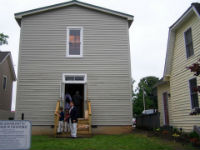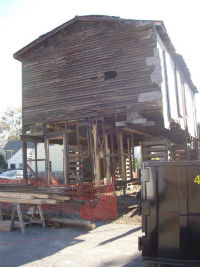On November 2, 2016, the Chicago Cubs have recently made baseball history by ending the longest ever championship drought by winning the World Series after 108 years. In 1908 there were 46 U.S. states, Thomas Edison was still alive, and the FM radio, sliced bread, and canned beer didn’t exist…
Inspired by the Huffington Post article, “What America Looked Like The Last Time The Cubs Won The World Series,” Kyle Fisher, a Preservation Maryland Waxter Intern, took a look at what Maryland architecture looked like in 1908. Play ball!
Wrigley Field, home of the Cubs, is also historically significant as the second-oldest major-league baseball stadium – second only to Boston’s Fenway Park – and the only remaining Federal League stadium. While here in Maryland, Camden Yards or even Memorial Stadium didn’t yet exist in 1908, there were many Maryland buildings constructed around the turn of the twentieth century that still remain and have been recognized for their historical importance:
Footer’s Dye Works Administrative Building
Cumberland, Allegheny County, Canal Place Maryland Heritage Area
The Footer’s Dye Works Administrative Building was constructed in 1906 when Cumberland was a thriving industrial town. The building remains a well-preserved example of early twentieth century industrial architecture. The last remaining building in the Footer’s Dye Works complex, this building housed the offices of the company and the cloth finishing and pressing services. In the 1920s, Footer’s Dye Works was one of the major fabric cleaning and dyeing companies of the Mid-Atlantic, employing up to 500 people. The company closed in 1936 and the complex was sold by 1949. Given its architectural significance and physical integrity, the building was placed on the National Register of Historic Places in 2013. Footer’s Dye Works Administrative Building was one of six sites to be awarded historic preservation state tax credits in 2016. The building is entering a new generation of use as it is converted into space for a brewpub, offices, and sixteen apartments.
Bagby Furniture Company
Designed by architect Alfred Mason, the Bagby Furniture Company building in Baltimore’s Little Italy is significantly associated with Baltimore’s once-thriving furniture industry. Bagby operated from 1879 to 1990, reaching prominence under William Hugh Bagby in the mid-twentieth century. It weathered the Great Depression by shifting from furniture manufacturing to wholesale furniture distribution. Baltimore’s port and railroads allowed for easy import of southern lumber, which gave entrepreneurs like the Bagbys a way to channel local cabinet-manufacturing labor into furniture production and sale. This building consists of three brick sections constructed in a U-shape between 1902 and 1907 on the corner of Exeter and Fleet streets. Redeveloped in 2009, the building now houses upscale restaurants. Another building constructed by Bagby Furniture Company on Biddle Street, now known as the Hoen Lithograph Co. building, is winner of 2016 historic preservation state tax credits and currently under redevelopment.
Charles Sumner Post #25
After the Civil War, soldiers organized a veteran fraternal association called the Grand Army of the Republic. The Republic was the only non-segregated social organization in the United States, and was instrumental in lobbying Congress for soldiers’ pensions and advocating for veterans. Over 400,000 veterans from North and South were involved with the GAR. The Charles Sumner Post #25 in Chestertown, Kent County, is only one of two GAR posts known to still exist. The two-story, front-gabled, wood frame building was built in 1908 and used mainly as a meeting space by veterans of the U.S. Colored Troops. It was named in honor of Sen. Charles Sumner of Massachusetts, a firm advocate for emancipation and abolition.
When the last member died in 1928, female family members maintained the building until selling it in 1950. In 1985 it passed to a developer, but Preservation Incorporated purchased it in 2002. In 1993 and 2002, Preservation Maryland provided grants to stabilize and restore the building. With generous support from the state and the county, the Kent County Arts Council oversaw the complete restoration of the structure in 2014. Today Post #25 continues to serve as a cultural center for the local African American community.
Post #25 is currently holding an exhibit in collaboration with the Smithsonian Institution on Main Street entitled, “The Way We Worked,” which explores the story of work in American culture over the past 150 years. The building is open to the public on weekends.
This post was researched and written by Kyle Fisher, one of Preservation Maryland’s Waxter Interns. Kyle’s work with us focuses on research and communications. He has a BA in Communications and History from Virginia Tech and a MA in Social Studies Education from Loyola University Maryland. Learn more about Kyle and our intern program here: presmd.org/waxter.





